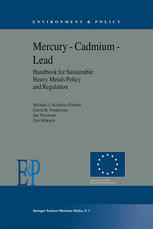

Most ebook files are in PDF format, so you can easily read them using various software such as Foxit Reader or directly on the Google Chrome browser.
Some ebook files are released by publishers in other formats such as .awz, .mobi, .epub, .fb2, etc. You may need to install specific software to read these formats on mobile/PC, such as Calibre.
Please read the tutorial at this link: https://ebookbell.com/faq
We offer FREE conversion to the popular formats you request; however, this may take some time. Therefore, right after payment, please email us, and we will try to provide the service as quickly as possible.
For some exceptional file formats or broken links (if any), please refrain from opening any disputes. Instead, email us first, and we will try to assist within a maximum of 6 hours.
EbookBell Team

5.0
110 reviewsAlthough this is a handbook for policy and regulation, the major part of it is filled with data on the three heavy metals that served as examples: mercury, cadmium and lead. Their stocks, productions, prices, trade flows, uses and applications, recovery and recycling, as well as their (eco)toxicological characteristics have been collected and presented to their fullest extent.
In addition, they are thoroughly analysed for consistency, future developments and trends and, of course, their consequences for sustainable development and future policy and regulation.
The second part, on policy and regulation, begins with an extensive and fundamental consideration on the characteristics of a sustainable heavy metals policy, whereby innovative policy tools are developed. In many aspects, these considerations are also valid for other metals and even non-metallic persistent substances.
Addressing the European Union in particular, its policy-making structure and practice are critically analysed, in order to develop feasible and viable guidelines for long-, medium- and short-term EU policy measures.
The results of this exercise are then applied to the three heavy metals. In each of these three chapters, all existing EU measures are presented in detail and confronted with better practices elsewhere, resulting in many suggestions and recommendations for the future. In the last chapter, the main conclusions and recommendations are carefully summarised. Together with a very extended table of contents, this makes the book easily accessible, in spite of its volume. This Handbook is a must for policy-makers and administrators at all levels, as well as for their counterparts in a wide variety of industries. In addition, it is well-suited for environmental science courses at academic or higher professional level.